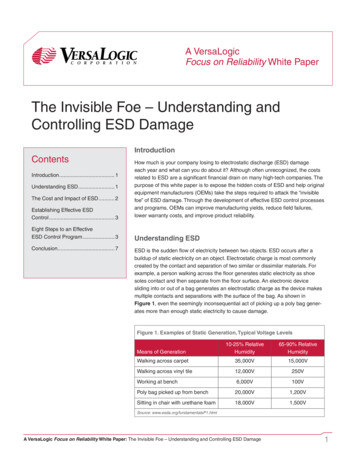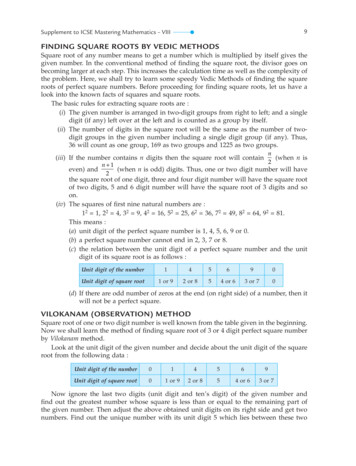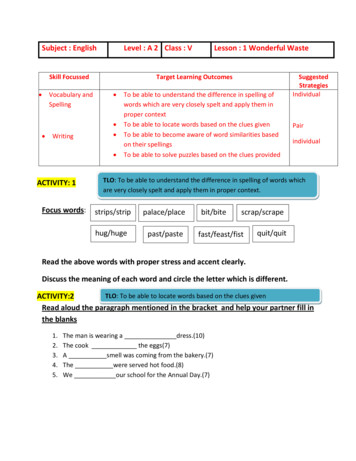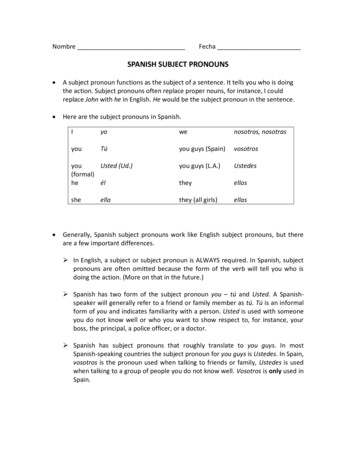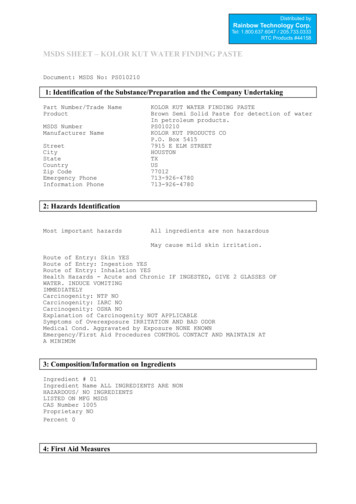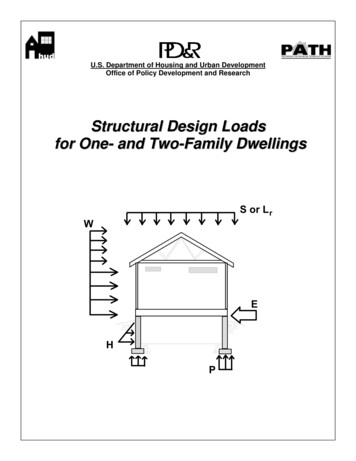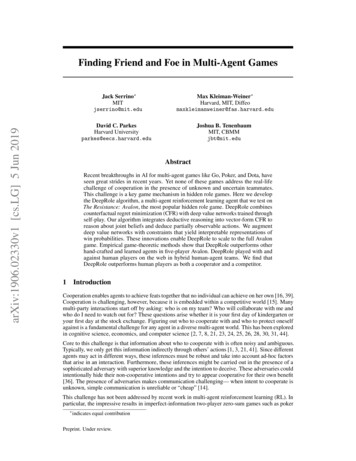
Transcription
arXiv:1906.02330v1 [cs.LG] 5 Jun 2019Finding Friend and Foe in Multi-Agent GamesJack Serrino MITjserrino@mit.eduMax Kleiman-Weiner Harvard, MIT, Diffeomaxkleimanweiner@fas.harvard.eduDavid C. ParkesHarvard Universityparkes@eecs.harvard.eduJoshua B. TenenbaumMIT, CBMMjbt@mit.eduAbstractRecent breakthroughs in AI for multi-agent games like Go, Poker, and Dota, haveseen great strides in recent years. Yet none of these games address the real-lifechallenge of cooperation in the presence of unknown and uncertain teammates.This challenge is a key game mechanism in hidden role games. Here we developthe DeepRole algorithm, a multi-agent reinforcement learning agent that we test onThe Resistance: Avalon, the most popular hidden role game. DeepRole combinescounterfactual regret minimization (CFR) with deep value networks trained throughself-play. Our algorithm integrates deductive reasoning into vector-form CFR toreason about joint beliefs and deduce partially observable actions. We augmentdeep value networks with constraints that yield interpretable representations ofwin probabilities. These innovations enable DeepRole to scale to the full Avalongame. Empirical game-theoretic methods show that DeepRole outperforms otherhand-crafted and learned agents in five-player Avalon. DeepRole played with andagainst human players on the web in hybrid human-agent teams. We find thatDeepRole outperforms human players as both a cooperator and a competitor.1IntroductionCooperation enables agents to achieve feats together that no individual can achieve on her own [16, 39].Cooperation is challenging, however, because it is embedded within a competitive world [15]. Manymulti-party interactions start off by asking: who is on my team? Who will collaborate with me andwho do I need to watch out for? These questions arise whether it is your first day of kindergarten oryour first day at the stock exchange. Figuring out who to cooperate with and who to protect oneselfagainst is a fundamental challenge for any agent in a diverse multi-agent world. This has been exploredin cognitive science, economics, and computer science [2, 7, 8, 21, 23, 24, 25, 26, 28, 30, 31, 44].Core to this challenge is that information about who to cooperate with is often noisy and ambiguous.Typically, we only get this information indirectly through others’ actions [1, 3, 21, 41]. Since differentagents may act in different ways, these inferences must be robust and take into account ad-hoc factorsthat arise in an interaction. Furthermore, these inferences might be carried out in the presence of asophisticated adversary with superior knowledge and the intention to deceive. These adversaries couldintentionally hide their non-cooperative intentions and try to appear cooperative for their own benefit[36]. The presence of adversaries makes communication challenging— when intent to cooperate isunknown, simple communication is unreliable or “cheap” [14].This challenge has not been addressed by recent work in multi-agent reinforcement learning (RL). Inparticular, the impressive results in imperfect-information two-player zero-sum games such as poker indicates equal contributionPreprint. Under review.
[4, 6, 27] are not straightforward to apply to problems where cooperation is ambiguous. In heads-uppoker, there is no opportunity to actually coordinate or cooperate with others since two-player zerosum games are strictly adversarial. In contrast, games such as Dota and capture the flag have beenused to train Deep RL agents that coordinate with each other to compete against other teams [17, 29].However, in neither setting was there ambiguity about who to cooperate with. Further in real-timegames, rapid reflexes and reaction times give an inherent non-strategic advantage to machines [9].Here we develop DeepRole, a multi-agent reinforcement learning algorithm that addresses thechallenge of learning who to cooperate with and how. We apply DeepRole to a five-player gameof alliances, The Resistance: Avalon (Avalon), a popular hidden role game where the challengeof learning who to cooperate with is the central focus of play [13]. Hidden role games start withplayers joining particular teams and adopting roles that are not known to all players of the game.During the course of the game, the players try to infer and deduce the roles of their peers while otherssimultaneously try to prevent their role from being discovered. As of May 2019, Avalon is the mosthighly rated hidden role game on boardgamegeek.com. Hidden role games such as Mafia, Werewolf,and Saboteur are widely played around the world.Related work DeepRole builds on the recent success of heuristic search techniques that combineefficient depth-limited lookahead planning with a value function learned through self-play in twoplayer zero-sum games [27, 33, 34]. In particular, the DeepStack algorithm for no-limit heads uppoker combines counterfactual regret minimization (CFR) using a continual re-solving local searchstrategy with deep neural networks [27, 45]. While DeepStack was developed for games where allactions are public (such as poker), in hidden role games some actions are only observable by someagents and therefore must be deduced. In Avalon, players obtain new private information as the gameprogresses while in poker the only hidden information is the initial set of cards.Contributions. Our key contributions build on these recent successes. Our algorithm integratesdeductive reasoning into vector-form CFR [19] to reason about joint beliefs and partially observableactions based on consistency with observed outcomes, and augments value networks with constraintsthat yield interpretable representations of win probabilities. This augmented network enables trainingwith better sample efficiency and generalization. We conduct an empirical game-theoretic analysis infive-player Avalon and show that the DeepRole CFR-based algorithm outperforms existing approachesand hand-crafted systems. Finally, we had DeepRole play with a large sample of human players on apopular online Avalon site. DeepRole outperforms people as both a teammate and opponent whenplaying with and against humans, even though it was only trained through self-play. We conclude bydiscussing the value of hidden role games as a long-term challenge for multi-agent RL systems.12round #345proposalround1 2 3 4 5succeedfail1 2 3 4 5fail1 2 3 4 5fail1 2 3 4 51 2 3 4 5succeedfail1 2 3 4 5fail12[2,3] [1,5]12345failsucceedproposal 2[4,3]approvalsucceed1 2 3 4 5proposal 1yesnomajority?succeednoyes1 2 3 4 5succeed15mission1 2 3 4 5privateactionssucceed1 fail2 failFigure 1: Description of the public game dynamics in The Resistance: Avalon. (left) Each round(rectangle) has up to 5 proposals (white circles) and leads to either a mission that fails or succeeds.(right) Example dynamics within each round. Players (colored circles) alternate proposing subsetsof players (2 or 3) to go on a mission which are then put to vote by all 5 players. If the majorityapproves, those players (1 & 5 in this example) privately and independently decide to succeed or failthe mission. If the majority disapproves, the next player proposes a subset.2
2The Resistance: AvalonWe first briefly describe game mechanics of The Resistance: Avalon played with five players. At thebeginning of the game, 3 players are randomly assigned to the Resistance team and 2 players areassigned to the Spy team. The spies know which players are on the Spy team (and hence also knowwhich players are on the Resistance team). One member of the Resistance team is randomly andprivately chosen to be the Merlin role who also knows all role assignments. One member of the Spyteam is randomly chosen to be the Assassin. At the end of the game, if the Resistance team has won,the Assassin guesses the identity of Merlin. If the Assassin guesses Merlin correctly then the Spyteam wins.Figure 1 shows a visual description of the public game dynamics. There are five rounds in the game.During each round a player proposes a subset (two or three depending on the round) of agents to goon a mission. All players simultaneously and publicly vote (approve or not approve) of that subset. Ifa simple majority do not approve, another player is selected to propose a subset to go on the mission.If after five attempts, no proposal receives a simple majority, the Spy team wins. If a simple majorityapproves, the subset of players privately select whether the mission succeeds or fails. Players onthe Resistance team must always choose success but players on the Spy team can choose successor failure. If any of the Spies choose to fail the mission, the mission fails. Otherwise, the missionsucceeds. The total number of success and fail votes is made public but the identity of who madethose votes is private. If three missions succeed, the Resistance team wins. If three missions fail,the Spy team wins. When people play Avalon, the games are usually rich in “cheap talk,” such asdefending oneself, accusing others, or debunking others’ claims [10]. In this work, we do not considerthe strategic implications of natural language communication.Although Avalon is a simple game to describe, it has a large state space. We compute a lower boundof 1056 distinct information sets in the 5-player version of Avalon (Appendix D for details). This islarger than the state space of Chess (1047 ) and larger than the number of information sets in heads-uplimit poker (1014 ) [18].3Algorithm: DeepRoleThe DeepRole algorithm builds off of recent success in poker by combining DeepStack’s innovationsof deep value networks and depth-limited solving with deductive reasoning. Unique to DeepRole,our innovations allow the algorithm to play games with simultaneous and hidden actions. In broadstrokes, DeepRole is composed of two parts: (1) a CFR planning algorithm augmented with deductivereasoning; and (2) neural value networks that are used to reduce the size of the game tree.Background. Hidden role games like Avalon can be modeled as extensive-form games. We followthe notation of [19]. Briefly, these games have a game tree with nodes that correspond to differenthistories of actions, h H, with Z H the set of terminal histories. For each h Z, let ui (h)be the utility to player i in terminal history h. In extensive-form games, only a single player P (h)can move at any history h, but because Avalon’s mechanics intimately involve simultaneous action,we extend this definition to let P 0 (h) be the set of players simultaneously moving at h. Historiesare partitioned into information sets (I Ii ) that represent the game states that player i cannotdistinguish between. For example, a Resistance player does not know who is on the Spy team andthus all h differing only in the role assignments to the other players are in a single information set.The actions available in a given information set are a A(I).A strategy σi for player i is a mapping for each I Ii to a probability distribution over A(I). Letσ (σ1 , . . . , σp ) be the joint strategy of all p players. Then, we let π σ (h) be the probability ofreaching h if all players act accordingto σ. We write πiσ (h) to mean the contribution of player i toQσσthe joint probability π (h) 1.p πiσ (h). Finally, let π i(h) be the product of strategies for allσ0players except i and let π (h, h ) be the probability of reaching history h0 under strategy σ, given hhas occurred.Counterfactual regret minimization (CFR) iteratively refines σ based on the regret accumulatedthrough a self-play like procedure. Specifically, in CFR , at iteration T , the cumulative counterfactualPttregret is Ri ,T (I, a) max{ T CF Vi (σI aP , I) CF Viσ(σ , I), 0}σ where the counterfactual valuesfor player i are defined as CF Vi (σ, I) z Z ui (z)π i (z[I])π (z[I], z) [38]. At a high-level,3
CFR iteratively improves σ by boosting the probability of actions that would have been beneficial toeach player. In two-player zero-sum games, CFR provably converges to a Nash equilibrium. However,it does not necessarily converge to an equilibrium in games with more than two players [37]. Weinvestigate whether CFR can generate strong strategies in a multi-agent hidden role game like Avalon.3.1CFR with deductive logicThe CFR component of DeepRole is based on the vector-form public chance sampling (PCS) versionof CFR introduced in [19], together with CFR regret matching [38]. Vector-form versions of CFRcan result in faster convergence and take advantage of SIMD instructions, but require a public gametree [20]. In poker-like games, one can construct a public game tree from player actions, since allactions are public (e.g., bets, new cards revealed) except for the initial chance action (giving playerscards). In hidden role games, however, key actions after the initial chance action are made privately,breaking the standard construction.To support hidden role games, we extend the public game tree to be a history of third-personobservations, o O(h), instead of just actions. This includes both public actions and observableconsequences of private actions (lines 22-44 in Alg. 1 in the Appendix). Our extension works whendeductive reasoning from these observations reveals the underlying private actions. For instance, ifa mission fails and one of the players is known to be a Spy, one can deduce that the Spy failed themission. deduceActions(h, o) carries out this deductive reasoning and returns the actions taken byeach player under each information set ( ai [I]) (line 23). With ai [I] and the player’s strategy (σ i ),the player’s reach probabilities are updated for the public game state following the observation (ho)(lines 24-26).Using the public game tree, we maintain a human-interpretable joint posterior belief b(ρ h) over theinitial assignment of roles ρ. ρ represents a full assignment of roles to players (the result of the initialchance action) – so our belief b(ρ h) represents the joint probability that each player has the rolespecified in ρ, given the observed actions in the public game tree. See Figure 2 for an example beliefb and assignment ρ. This joint posterior b(ρ h) can be approximated by using the individual players’strategies as the likelihood in Bayes rule:Yb(ρ h) b(ρ)(1 1{h ρ})πiσ (Ii (h, ρ))(1)i 1.pwhere b(ρ) is the prior over assignments (uniform over the 60 possible assignments), Ii (h, ρ) is theinformation set implied by public history h and assignment ρ, and the product is the likelihood ofplaying to h given each player’s implied information set. A problem is that this likelihood can putpositive mass on assignments that are impossible given the history. This arises because vector-formCFR algorithms can only compute likelihoods for each player independently rather than jointly. Forinstance, consider two players that went on a failing mission. In the information sets implied by the ρwhere they are both resistance, each player is assumed to have passed the mission. However, thisis logically inconsistent with the history, as one of them must have played fail. To address this, theindicator term (1 1{h ρ}) zeros the probability of any ρ that is logically inconsistent with thepublic game tree h. This zeroing removes any impact these impossible outcomes would have had onthe value and regret calculations in CFR (line 20 in Alg. 2).3.2Value networkThe enhanced vector-form CFR cannot be run on the full public game tree of Avalon (or any realhidden role game). This is also the case for games like poker, so CFR-based poker systems [6, 27]rely on action abstraction and state abstraction to reduce the size of the game tree. However, actionsin Avalon are not obviously related to each other. Betting 105 chips in poker is strategically similarto betting 104 chips, but voting up a mission in Avalon is distinct from voting it down. The size ofAvalon’s game tree does not come from the number of available actions, but rather from the numberof players. Furthermore, since until now Avalon has only received limited attention, there are nodeveloped hand-crafted state abstractions available either (although see [5] for how these could belearned). We follow the general approach taken by [27], using deep neural networks to limit the sizeof the game tree that we traverse (lines 14-16 in Alg. 1 in Appendix A).We first partition the Avalon public game tree into individually solvable parts, segmented by aproposal for every possible number of succeeded and failed missions (white circles on the left side4
Dense (ReLU)One-hot encoding ofproposer position[0 1 0 0 0]5x1Probability-weightedvalue of eachinformation setP(Ii)*Vi(Ii)Win likelihoodP(win role ( ))P1 P2 P3 P4 P5 P(win)Public belief stateb P(role ( ))P1 P2 P3 P4 P5 PrMRRSA .15MRSRA .12MSRRA .00 SARRM .00RSARM .0380x160x180x1MRRSA.96MRSRA.73MSRRA.55RM.23 60x1SARSRARM.41RM(2,3).5 -.2X S(4)A(5).3 -.11 x 15P11 x 15P21 x 15P31 x 15P41 x 15P5Figure 2: DeepRole neural network architecture used to limit game tree depth. Tables (black headers)show example inputs. The uppercase characters represent the different roles: (R)esistance, (S)py,(M)erlin, (A)ssassin. The outputs are the probability weighted value for each player in each of theirinformation sets. While there is only one information set for Resistance (since they only know theirown role), there are multiple for each of the other roles types. “M (2,3)” should be read as Merlinwho sees players 2 and 3 as Spy and “S (4)” should be read as Spy who sees player 4 as Assassin.of Figure 1). This yields 45 neural networks. Each h corresponding to a proposal is mapped to oneof these 45 networks. These networks take in a tuple θ Θ, θ (i, b) where i is the proposingplayer, and b is the posterior belief at that position in the game tree. Θ is the set of all possiblegame situations. The value networks are trained to predict the probability-weighted value of eachinformation set (Figure 2).Unlike in DeepStack, our networks calculate the non-counterfactual (i.e. normal) values for everyinformation set I for each player. This is because our joint belief representation loses the individualcontribution of each player’s likelihood, making it impossible to calculate a counterfactual. The valueVi (I) for private information I for player i can be written as:XXσVi (I) πiσ (I)π i(h)π σ (h, z)ui (z) πiσ (I) CF Vi (I)z Zh Iwhere players play according to a strategy σ. Since we maintain a πiσ (I) during planning, we canconvert the values produced by the network to the counterfactual values needed by CFR (line 15 inAlg. 2).Value network architecture While it’s possible to estimate these values using a generic feedforward architecture, it may cause lower sample efficiency, require longer training time, or failto achieve a low loss. We design an interpretable custom neural network architecture that takesadvantage of restrictions imposed by the structure of many hidden role games. Our network feedsa one-hot encoded vector of the proposer player i and the belief vector b into two fully-connectedhidden layers of 80 ReLU units. These feed into a fully-connected win probability layer with sigmoidactivation. This layer is designed to take into account the specific structure of V , respecting the binarynature of payoffs in Avalon (players can only win or lose). It explicitly represents the probability of aResistance win ( w P (win ρ)) for each assignment ρ.Using these probabilities, we then calculate the Vi (I) for each player and information set, constrainingthe network’s outputs to sound values. To do this calculation, for each player i, win probabilities DeepRoleNo Win Layer0.00060.000420DeepRoleNo Win Layer406080100Training samples (1000)5Figure 3: DeepRole generalizationand sample efficiency. (left) Generalization error on held out samples averaged across the 45 neural networks.(right) Generalization error as a function of training data for the first deepvalue network (averaged over N 5runs, intervals are SE).
RandomP(Win)LogicBotISMCTSMOISMCTSCFR DeepRole Other0.750.500.25P(S Win)0.000.750.50 DeepRole (S) Other (S)0.25P(R Win)0.00 DeepRole (R) Other (R)0.750.500.250.000123# DeepRole40123# DeepRole40123# DeepRole40123# DeepRole40123# DeepRole4Figure 4: Comparing the expected win rate of DeepRole with other agents. The x-axis shows howmany of the first four agents are DeepRole. The y-axis shows the expected win rate for the fifth agentif they played as DeepRole or the benchmark. Standard errors smaller than the size of the dots. (top)Combined expected win rate. (middle) Spy-only win rate. (bottom) Resistance-only win rate. - ui (1 w ) representing i’s payoff in each ρ if resistancefirst converted to expected values ( ui wwin. It is then turned into the probability-weighted value of each information set which is used and i Mi [( ui w - ui (1 w )) b] where Mi is a (15 60) multi-one-hot matrixproduced by CFR: Vmapping each ρ to player i’s information set, and b is the belief over roles passed to the network. Thisarchitecture is fully differentiable and is trained via back-propagation. A diagram and description ofthe full network is shown in Figure 2. See Appendix B and Alg. 3 for details of the network trainingalgorithm, procedure, parameters and compute details.The win probability layer enabled training with less training data and better generalization. Whencompared to a lesioned neural network that replaced the win probability layer with a zero-sumlayer (like DeepStack) the average held-out loss per network was higher and more training data wasrequired (Figure 3).4Empirical game-theoretic analysisThe possibility of playing with diverse teammates who may be playing conflicting equilibriumstrategies, out-of-equilibrium strategies, or even human strategies makes evaluation outside of twoplayer zero-sum games challenging. In two-player zero-sum games, all Nash equilibria are minimallyexploitable, so algorithms that converge to Nash are provably optimal in that sense. Howeverevaluating 3 player interactions requires considering multiple equilibria and metrics that account forcoordinating with teammates. Further, Elo and its variants such as TrueSkill are only good measuresof performance when relative skill is intransitive, but have no predictive power in transitive games(e.g., rock-paper-scissors) [40]. Thus, we turn to methods for empirical game-theoretic analysiswhich require running agents against a wide variety of benchmark opponents [40, 42].We compare the performance of DeepRole to 5 alternative baseline agents: CFR – an agent trainedwith MCCFR [22] over a hand-crafted game abstraction; LogicBot – a hand-crafted strategy that useslogical deduction; RandomBot - plays randomly; ISMCTS - a single-observer ISMCTS algorithmfound in [11, 12, 35]; MOISMCTS - a multiple-observer variant of ISMCTS [43]. Details for theseagents are found in Appendix C.We first investigated the conditional win rates for each baseline agent playing against DeepRole. Weconsider the effect of adding a 5th agent to a preset group of agents and compare DeepRole’s winrate as the 5th agent with the win rate of a baseline strategy as the 5th agent in that same preset group.For each preset group (0-4 DeepRole agents) we simulated 20K games.6
DeepRoleCFRDeepRoleNo Win LayerNo DeductionLogicBotDeepRole100No Win LayerDeepRole10DeepRole30Figure 5: Empirical game-theoretic evaluation. Arrow size and darkness are proportional to the sizeof the gradient. (left) DeepRole against hand-coded agents. (center) DeepRole compared to systemswithout our algorithmic improvements. (right) DeepRole against itself but with CFR iterations equalto the number next to the game.Figure 4 shows the win probability of each of these bots when playing DeepRole both overall andwhen conditioning on the role (Spy or Resistance). In most cases adding a 5th DeepRole playeryielded a higher win rate than adding any of the other bots. This was true in every case we testedwhen there were at least two other DeepRole agents playing. Thus from an evolutionary perspective,DeepRole is robust to invasion from all of these agent types and in almost all cases outperforms thebaselines even when it is the minority.To formalize these intuitions we construct a meta-game where players select a mixed meta-strategyover agent types rather than actions. Figure 5 shows the gradient of the replicator dynamic in thesemeta-games [40, 42]. First, we compare DeepRole to the two hand-crafted strategies (LogicBot andCFR), and show that purely playing DeepRole is the equilibrium with the largest basin of attraction.The ISMCTS agents are too computationally demanding to run in these contests, but in a pairwiseevaluation, playing DeepRole is the sole equilibrium.Next, we test whether our innovations make DeepRole a stronger agent. We compare DeepRole totwo lesioned alternatives. The first, DeepRole (No Win Layer), uses a zero-sum sum layer instead ofour win probability layer in the neural network. Otherwise it is identical to DeepRole. In Figure 3, wesaw that this neural network architecture did not generalize as well. We also compare to a version ofDeepRole that does not include the logical deduction step in equation 1, and also uses the zero-sumlayer instead of the probability win layer (No Win Layer, No Deduction). The agent without deductionis the weakest, and the full DeepRole agent is the strongest, showing that our innovations lead toenhanced performance.Finally, we looked at the impact of CFR solving iterations during play (thinking time). More iterationsmake each move slower but may yield a better strategy. When playing DeepRole variants with 10, 30,and 100 iterations against each other, each variant was robust to invasion by the others but the moreiterations used, the larger the basin of attraction (Figure 5).Adding DeepRole or a Humanto 4 DeepRoleto 4 Human DeepRoleOverallResistanceSpy Human DeepRole HumanWin Rate (%)(N)Win Rate (%)(N)Win Rate (%)(N)Win Rate (%)(N)46.9 0.634.4 0.765.6 0.9(7500)38.8 1.325.6 1.557.8 2.0(1451)60.0 5.551.4 8.267.4 7.1(80)48.1 1.240.3 1.559.7 Table 1: Win rates for humans playing with and against the DeepRole agent. When a human replacesa DeepRole agent in a group of 5 DeepRole agents, the win rate goes down for the team that thehuman joins. When a DeepRole agent replaces a human in a group of 5 humans, the win rate goes upfor the team the DeepRole agent joins. Averages standard errors.7
Pr(true spy roles)3 passed1.00Figure 6: Belief dynamics over the course ofthe game. (left) DeepRole’s posterior belief inthe ground truth Spy role assignments as a Resistance player with four humans. (right) DeepRole’s posterior belief of the true spy teamwhile observing all-human games from the perspective a Resistance player.0.750.500.250.00R1R2R3R4R5Game stage (round)53 failedR1R2R3R4R5Game stage (round)Human evaluationPlaying with and against human players is a strong test of generalization. First, humans are likely toplay a diverse set of strategies that will be challenging for DeepRole to respond to. During trainingtime, it never learns from any human data and so its abilities to play with people must be the resultof playing a strategy that generalizes to human play. Importantly, even if human players take theDeepRole neural networks “out of distribution”, the online CFR iterations can still enable smart playin novel situations (as with MCTS in AlphaGo).Humans played with DeepRole on the popular online platform ProAvalon.com (see Appendix Ffor commentated games and brief descriptions of DeepRole’s “play style”). In the 2189 mixedhuman/agent games we collected, all humans knew which players were human and which wereDeepRole. There were no restrictions on chat usage for the human players, but DeepRole did not sayanything and did not process sent messages. Table 1 shows the win rate of DeepRole compared tohumans. On the left, we can see that DeepRole is robust; when four of the players were DeepRole, aplayer would do better playing the DeepRole strategy than playing as an average human, regardlessof team. More interestingly, when considering a game of four humans, the humans were betteroff playing with the DeepRole agent as a teammate than another human, again regardless of team.Although we have no way quantifying the absolute skill level of these players, among this pool ofavid Avalon players, DeepRole acted as both a superior cooperator and competitor – it cooperatedwith its teammates to compete against the others.Finally, DeepRole’s interpretable belief state can be used to gain insights into play. In Figure 6 weshow DeepRole’s posterior probability estimate of the true set of Spies when playing as a Resistanceplayer. When DeepRole played as the sole agent among four humans (left plot), the belief staterapidly converged to the ground truth in the situations where three missions passed, even though ithad never been trained on human data. If three missions failed, it was often because it failed to learncorrectly. Next, we analyze the belief state when fed actions and observations from the perspective ofa human resistance player playing against a group of humans (yoked actions). As shown in Figure 6,the belief estimates increase as the game progresses, indicating DeepRole can make correct inferenceseven while just observing the game. The belief estimate converges to the correct state faster in gameswith three passes, presumably because the data in these games was more informative to all players.6DiscussionWe developed a new algorithm for multi-agent games called DeepRole which effectively collaboratesand competes with a diverse set of agents in The Resistance: Avalon. DeepRole surpassed bothhumans and existing machines in both simulated contests against other agents and a real-worldevaluation with human Avalon players. These results are achieved thr
limit poker (1014) [18]. 3 Algorithm: DeepRole The DeepRole algorithm builds off of recent success in poker by combining DeepStack’s innovations of deep value networks and depth-limited solving with deductive reasoning. Unique to DeepRole, our innovations allow the algorithm to play

